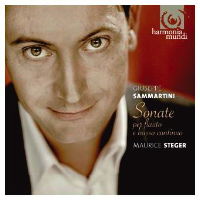
Shaken and Stirred
Maurice Steger plays
Giuseppe Sammartini -
recommended by
JENNIFER PAULL'One can touch their joy ...'
|

|
Time is a dressmaker specializing in alterations. -- Faith Baldwin (1893-1978), US author of romance and fiction
I am the first to admit that I find the separation of Baroque music into historically informed performance as opposed to -- what? -- disturbing. How fashions change! Would Glenn Gould have been appreciated had he been in his youth today?
The implication is that those of us who play contemporary instruments are unaware of how to be musically educated in performance of the various epochs of music that preceded the fabrication of the tools of our trade. I deeply regret that this apartheid within our own small zone of 'classical' music makes for cliques and sectarian ill-feeling.
It doesn't work in reverse. Nobody complains about a violin concerto by Béla Bartók or a Lark Ascending by Ralph Vaughan Williams being performed upon an instrument that was made a few hundred years before the piece was written. One does not presume the musicality to be 'wrong' because the instrument doesn't fit the same moment in history. After all, neither does the musician and (s)he can and should learn about the styles and performance of many.
I have listened to countless academically 'correct' and lifeless performances of Baroque music and have been left wondering just how it is possible to presume one has to be considered in the right per se simply because one is playing a facsimile of an ancient instrument. One can still play with two left feet. Are those who play contemporary instruments, therefore, guilty of the opposite just because their instruments have a key or two -- or, sometimes, rather better tuning? This optic does depend upon geography -- where you happen to be situated when you play. Countries differ, as well we know.
The strict adherence to historical treatises, evidence of historical performance practice (both stylistically shaken and technically stirred) can be lifeless. The movement may have originated in the performance of Mediaeval, Renaissance and Baroque music but today we have Classical and Romantic styles as 'historically informed'. One is reaching the point at which it could be considered a musical sin to play Debussy on a German bassoon -- and Bach upon a French, even a French Baroque bassoon.
Uniformity of credo has not yet taken over the entire planet in more ways than one, which is an excellent thing. Vive la difference! In any case, we all have much to learn from each other. May the sluice gates of reason remain wide open! Personally, I firmly adhere to the avant-garde of post-Puritan Lib.
In the words of the great Cathy Berberian, my mentor, 'There is good and bad -- nothing else!'
Some people walk in the rain, others just get wet. -- Roger Miller (1936-1992), US singer, songwriter and musician
From the first note of this CD one is transported into a rainbow of scintillating colour and deep passion. Everything about it is perfect: the ensemble performance, the tempi, the ornamentation (a delight) and the musicianship, which is spellbinding.
Listen -- Sammartini: Allegro (Sonata in E minor, Op 2 No 3)
(track 1, 0:01-0:54) © 2007 harmonia mundi sa
I have always admired the Sammartini brothers, Giuseppe and Giovanni; a brace rather like the Marcellos (Alessandro and Benedetto). There were even more Loeillets (as cousins were included) and, as we know, considerably more Caix and Bachs where one didn't stop at cousins.
This chamber music is not the monotonous question and answer, the simplistic knitting pattern of many of the less motivated works of the period. It is true pleasure and superbly interpreted.
Listen -- Sammartini: Adagio (Sonata in G, Op 30 No 1)
(track 20, 0:00-0:15) © 2007 harmonia mundi sa
The musicians are having a jam session and loving every minute. One can touch their joy; it's tangible, cheeky and spellbinding. Maurice Steger is to the recorder what San Getz was to the saxophone -- sensuality personified.
Technique is what you fall back on when you run out of inspiration. -- Rudolf Nureyev (1938-1993), Russian dancer and choreographer
No lack of either here, simply pleasure for the ear and an abundance of inspiration that makes me dream of the day when music will be music again and the end to which all roads lead. Am I interested in the year of fabrication of the 'cello in the recording?
The most important thing is the bringing to life of this beautiful chamber music. Beneath the inspired direction of Maurice Steger, whose playing is a treat of virtuosity with as much heart and love as HIP, it not only comes to life but is truly intoxicating.
Listen -- Sammartini: Adagio (Sonata in G, Op 13 No 4)
(track 24, 0:57-1:22) © 2007 harmonia mundi sa
Why waste money on psychotherapy when you can listen to the B Minor Mass? -- Michael Torke (born 1961), US composer and recording artist
I couldn't agree more, but for any lesser than mortal conundrums of life's psychiatric tsunamis, Sammartini will substitute surprisingly well.
Copyright © 11 February 2009
Jennifer I Paull, Vouvry, Switzerland
 BUY CLASSICAL CDS ONLINE
CD INFORMATION: GIUSEPPE SAMMARTINI SONATAS
GIUSEPPE SAMMARTINI
'CATHY BERBERIAN AND MUSIC'S MUSES' BY JENNIFER PAULL
BUY CLASSICAL CDS ONLINE
CD INFORMATION: GIUSEPPE SAMMARTINI SONATAS
GIUSEPPE SAMMARTINI
'CATHY BERBERIAN AND MUSIC'S MUSES' BY JENNIFER PAULL
| 
